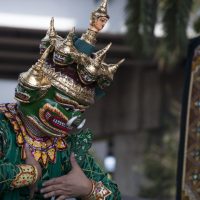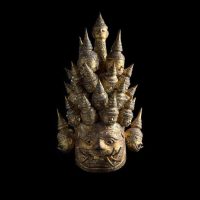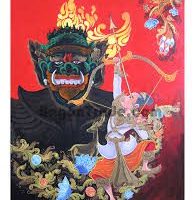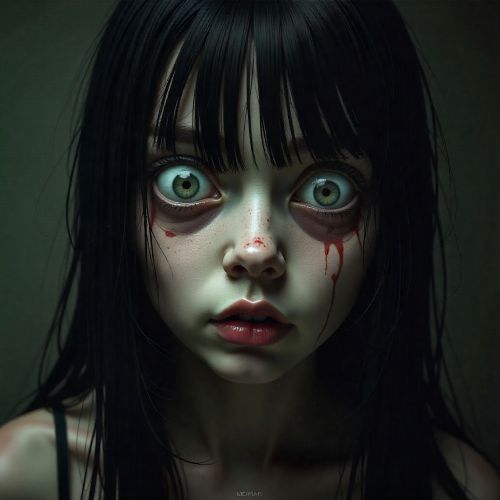Dathagiri : The Burmese Demon King of the Ramayana Tradition
Listen
At a glance
| Description | |
|---|---|
| Origin | Burmese Mythology |
| Classification | Mortals |
| Family Members | Vibhisana (Brother) |
| Region | Burma (Myanmar) |
| Associated With | Royalty |
Dathagiri
Introduction
Dathagiri, known in Burmese as ဒဿဂီရိ, is one of the most striking figures in Myanmar’s Yama Zatdaw, a locally evolved form of the Ramayana that blends Buddhist values with Southeast Asian storytelling. Although the plot parallels the Indian epic, Dathagiri emerges as a uniquely Burmese character whose personality, motivations, and symbolism have been shaped by centuries of cultural adaptation. His abduction of <a class="wpil_keyword_link" href="https://mythlok.com/thida/" title="Thida : The Iconic Heroine of the Burmese Ramayana” data-wpil-keyword-link=”linked” data-wpil-monitor-id=”8249″>Thida (Sita) becomes the defining event of the narrative, driving Yama (Rama) on his quest to restore justice. Far more than a simple villain, Dathagiri embodies ambition, passion, and the karmic consequences of desire. Through performance, literature, and art, he has become a deeply embedded figure in Burmese imagination—both feared and fascinating.
Physical Traits
In Burmese tradition, Dathagiri is portrayed with an imposing and supernatural appearance that emphasizes his role as a powerful demon king. He is often depicted with multiple heads, typically ten, representing heightened awareness, strategic intelligence, and an overwhelming breadth of power. Burmese artistic styles amplify his terrifying beauty through exaggerated facial expressions, sharp teeth, and intense, wide eyes. His multiple arms, sometimes numbering twenty in classical depictions, signify his unmatched combat skill and his ability to wield several celestial weapons at once.
Dathagiri’s attire reflects Myanmar’s royal aesthetics rather than Indian styles. He is shown wearing golden crowns, layered armour, lacquered chest pieces, and intricate ornaments that align with traditional Burmese dance-drama costumes. In theatre and marionette puppetry, his mask is richly decorated with bold pigments and gilding, giving him a commanding presence on stage. These visual elements turn Dathagiri into an unmistakably Burmese cultural icon.
Family
Dathagiri’s family is framed within the moral structure of the Yama Zatdaw, highlighting loyalty, conflict, and ethical contrast. His household includes influential brothers, especially Vibhishana, whose decision to align with Yama is treated in Burmese versions as a profoundly moral choice reflecting Buddhist ideals. Within this narrative, Vibhishana’s righteousness serves as a counterweight to Dathagiri’s unchecked ambition, emphasizing that virtue can emerge even from within a demon lineage.
Dathagiri’s royal circle forms a crucial backdrop to his decisions, offering counsel and warnings that he frequently disregards. His relationships are depicted in emotional and psychological terms, focusing less on genealogy and more on the moral tension within his kingdom. This approach adds a distinctly Burmese depth to his character, portraying him not as an isolated villain but as a ruler whose downfall impacts and divides those closest to him.
Other names
While “Dathagiri” is his most widely recognised Burmese name, the character appears under several local variants shaped by historical manuscripts and regional dialects. In some classical sources, he is called Datha-giri, while in older recitations, he occasionally appears as Yawana. The designation King of Thiho (Lanka) is also used in Burmese theatrical traditions, emphasizing his sovereign status rather than his demonic nature.
These name variations highlight how Burmese culture absorbed the epic into its own storytelling systems. Instead of maintaining a single imported identity, Dathagiri evolved linguistically and conceptually into a figure grounded in the Burmese worldview.
Powers and Abilities
Dathagiri stands at the center of the Yama Zatdaw as a being of immense supernatural might. His strength is legendary, allowing him to confront armies, divine beings, and magical creatures. Burmese performances emphasize his mastery of illusion, a key element in scenes where deceptive transformations alter the course of the narrative. Illusory magic becomes one of his defining gifts, symbolizing his ability to manipulate perception and reality to achieve his desires.
His command over Thiho grants him access to vast resources, legions of supernatural followers, and a fortified island kingdom. In battle, he wields enchanted weapons and employs rituals drawn from esoteric knowledge, demonstrating a king who has mastered both martial and mystical arts. These abilities reinforce a central theme in Burmese retellings: power without moral restraint inevitably leads to one’s downfall.
Modern Day Influence
Dathagiri remains a vivid presence in Myanmar’s cultural landscape. He is one of the principal characters in zat pwe (traditional dance-drama) performances, where episodes from the Yama Zatdaw continue to captivate audiences during festivals, temple ceremonies, and state events. The scenes featuring Dathagiri—especially the abduction of Thida or the final confrontation with Yama—are often the most dramatic moments on stage.
In Burmese marionette theatre (yoke thé), puppet-makers invest extraordinary detail into Dathagiri’s figure. His puppet form typically includes moving jaws, hinged crowns, and vibrant colours to convey authority and menace, making him a favourite character in these intricately choreographed performances.
Dathagiri also appears in temple murals, illustrated manuscripts, lacquerware art, and modern Burmese comics, demonstrating his enduring relevance across visual and literary media. Contemporary writers and filmmakers sometimes portray him sympathetically, focusing on his internal struggle and emotional vulnerability. These modern interpretations highlight his tragic depth, presenting him as a king driven by longing and fate rather than unrestrained evil.
As a symbol, Dathagiri represents the consequences of unchecked desire, the burden of power, and the complex line between devotion and obsession. In Burmese Buddhist thought, his story often becomes a reflection on karma, reminding audiences that even the mightiest rulers cannot escape the moral weight of their actions.
Related Images
Source
Aung, T. M. (2023). Myths and Spirits in Modern Myanmar. Yangon Press.
Hlaing, K. (2024). Burmese Mythical Creatures and Legends. Myanmar Journal of Folklore, 12(3), 45-63.
Maung, S. (2025). The Ramayana in Burmese Culture: A Study of Yama and Dathagiri. Mandalay University Press.
Myint, N. (2021). Burmese Mythology Overview. Retrieved from https://en.wikipedia.org/wiki/Burmese_mythology
Oo, L. (2025). The Story of the Nats and Spirits in Myanmar. Journal of Southeast Asian Studies, 30(2), 78-94.
Win, M. T. (2023). Demon Kings of Southeast Asia: A Comparative Analysis. Asian Mythological Review, 8(1), 102-117.
Zaw, P. (2025). Burmese Cultural Heritage through Myth and Dance. Yangon Arts Review, 15(1), 23-39.
Wikipedia contributors. (2025). Mythical creatures in Burmese folklore. In Wikipedia. Retrieved from https://en.wikipedia.org/wiki/Mythical_creatures_in_Burmese_folklore
Tu, H. M. (2025). From Hindu villain to heroic Buddhist king: Dathagiri in the Thiri Rama (Master’s thesis, University of Illinois Urbana-Champaign). IDEALS. https://www.ideals.illinois.edu/items/136357
Academia.edu. (n.d.). Ravana (called Dathagiri in the Burmese tradition). Retrieved from https://www.academia.edu/figures/10310293/figure-113-ravana-called-dathagiri-in-the-burmese-tradition
Richman, P. (1991). Many Ramayanas: The diversity of a narrative tradition in South Asia. Berkeley: University of California Press.
Sarkar, S. (2017). The Ramayana in Southeast Asia: Cultural adaptations and transformations. Journal of Asian Studies, 76(3), 589–612.
Tin, M. (2009). Burmese adaptations of the Ramayana. Yangon: Myanmar Historical Society Press.
Blackburn, A. (2001). Buddhist connections in Southeast Asian literature. Honolulu: University of Hawai‘i Press.
De, N. (2015). Epic transformations: Ravana across cultures. Comparative Literature Review, 12(2), 145–168.
Frequently Asked Questions
Who is Dathagiri in Burmese mythology?
Dathagiri is the demon king and central antagonist of Myanmar’s Yama Zatdaw, playing a pivotal role in the abduction of Thida.
How is Dathagiri different from Ravana?
While inspired by Ravana, Dathagiri evolved independently through Burmese theatre, Buddhist teachings, and local artistic traditions, becoming a culturally distinct character.
What powers does Dathagiri possess?
He has immense physical strength, mastery of magical illusions, esoteric knowledge, and the authority of the island kingdom Thiho.
How is Dathagiri depicted in Burmese arts?
He appears with multiple heads, ornate crowns, and traditional Burmese armour in dance-drama, puppetry, murals, and festival performances.
Why is Dathagiri significant in Myanmar today?
His character remains central to cultural performances and artistic storytelling, symbolizing themes of power, desire, karma, and moral consequence.









